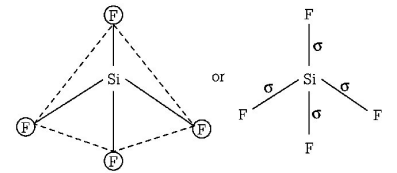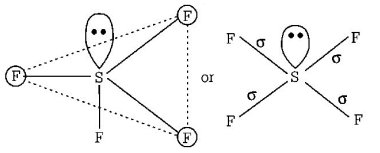Question
Among the following, the pair in which the two species are not isostructural, is
A.
$$Si{F_4}\,{\text{and}}\,S{F_4}$$
B.
$$lO_3^ - \,{\text{and}}\,Xe{O_3}$$
C.
$$BH_4^ - \,{\text{and}}\,NH_4^ + $$
D.
$$PF_6^ - \,{\text{and}}\,S{F_6}\,$$
Answer :
$$Si{F_4}\,{\text{and}}\,S{F_4}$$
Solution :
$$Si{F_4}$$ and $$S{F_4}$$ are not isostructural because $$Si{F_4}$$ is tetrahedral due to $$s{p^3}$$ hybridisation of $$Si.$$
$${}_{14}Si = 1{s^2},2{s^2},2{p^6},3{s^2}3{p^2}$$ ( in ground state )
$${}_{14}Si = 1{s^2},2{s^2}2{p^6},3{s^1}3{p^3}$$ ( in excited state )

Hence, four equivalent $$s{p^3}$$ hybrid orbitals are obtained and they are overlapped by four $$p - {\text{orbitals}}$$ of four fluorine atoms on their axis. Thus, it shows following structure:

While $$S{F_4}$$ is not tetrahedral but it is arranged in trigonal bipyramidal geometry (has see saw shape) because in it $$S$$ is $$s{p^3}d$$ hybrid.
$${}_{16}S = 1{s^2},2{s^2}2{p^6},3{s^2}3p_x^23p_y^13p_z^1$$ ( in ground state )
$$ = 1{s^2},2{s^2}2{p^6},\underbrace {3{s^2}3p_x^13p_y^13p_z^13d_{xy}^1}_{s{p^3}d\,\,{\text{hybridisation}}}$$ ( in first excitation state )

Hence, five $$s{p^3}d$$ hybrid orbitals are obtained. One orbital is already paired and rest four are overlapped with four $$p - {\text{orbitals}}$$ of four fluorine atoms on their axis in trigonal bipyramidal form.
This structure is distorted from trigonal bipyramidal to tetrahedral due to involvement of repulsion between lone pair and bond pair.
$$Si{F_4}$$ and $$S{F_4}$$ are not isostructural because $$Si{F_4}$$ is tetrahedral due to $$s{p^3}$$ hybridisation of $$Si.$$
$${}_{14}Si = 1{s^2},2{s^2},2{p^6},3{s^2}3{p^2}$$ ( in ground state )
$${}_{14}Si = 1{s^2},2{s^2}2{p^6},3{s^1}3{p^3}$$ ( in excited state )

Hence, four equivalent $$s{p^3}$$ hybrid orbitals are obtained and they are overlapped by four $$p - {\text{orbitals}}$$ of four fluorine atoms on their axis. Thus, it shows following structure:

While $$S{F_4}$$ is not tetrahedral but it is arranged in trigonal bipyramidal geometry (has see saw shape) because in it $$S$$ is $$s{p^3}d$$ hybrid.
$${}_{16}S = 1{s^2},2{s^2}2{p^6},3{s^2}3p_x^23p_y^13p_z^1$$ ( in ground state )
$$ = 1{s^2},2{s^2}2{p^6},\underbrace {3{s^2}3p_x^13p_y^13p_z^13d_{xy}^1}_{s{p^3}d\,\,{\text{hybridisation}}}$$ ( in first excitation state )

Hence, five $$s{p^3}d$$ hybrid orbitals are obtained. One orbital is already paired and rest four are overlapped with four $$p - {\text{orbitals}}$$ of four fluorine atoms on their axis in trigonal bipyramidal form.
This structure is distorted from trigonal bipyramidal to tetrahedral due to involvement of repulsion between lone pair and bond pair.